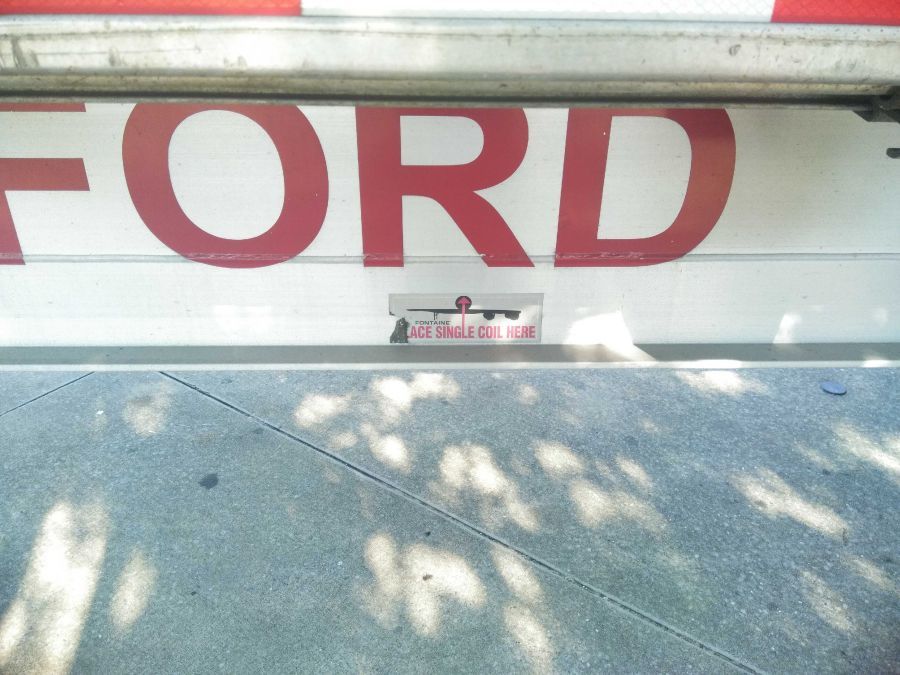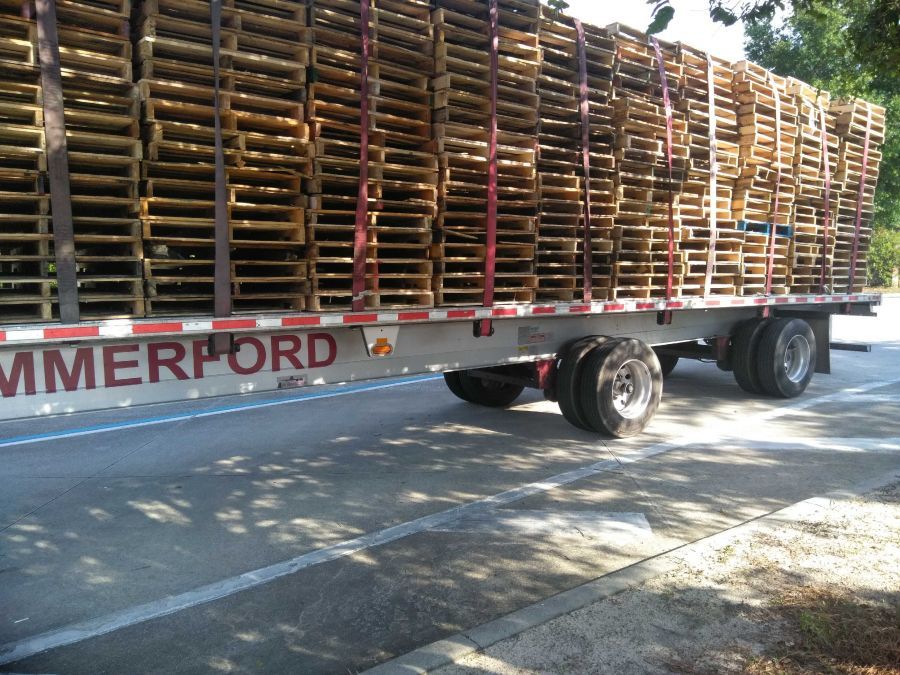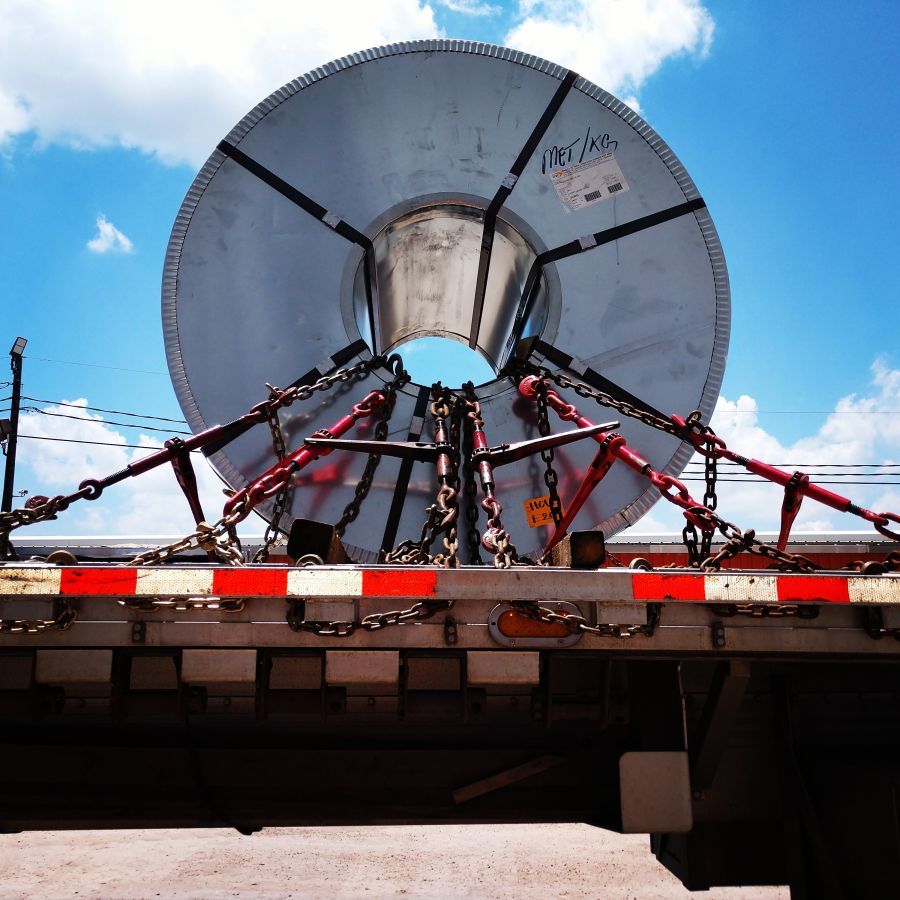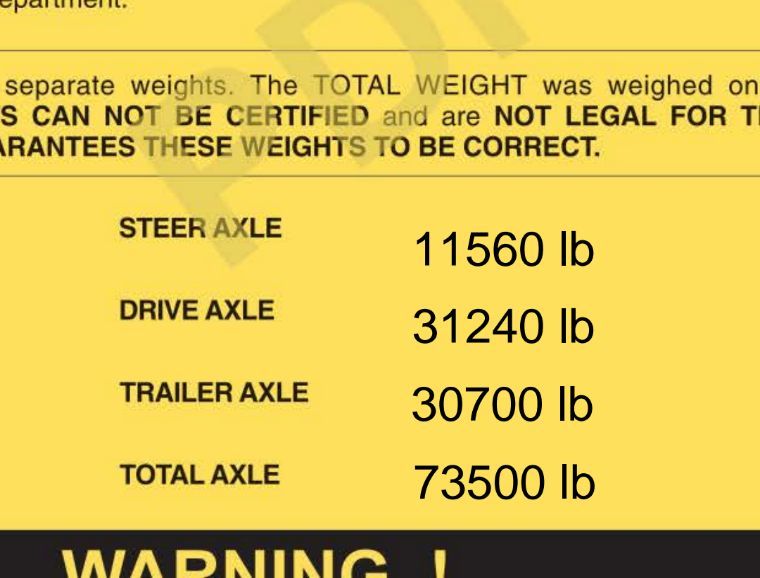Flatbed Weight Distribution
Topic 25868 | Page 2
Typically, the center of a 53' spread axle trailer, is 14 stake pockets, then the middle spool after the 14th pocket, (or 14.5 stake pockets) . Which is normally directly in front of the turn signal light.
Typically, the center of a 53' spread axle trailer, is 14 stake pockets, then the middle spool after the 14th pocket, (or 14.5 stake pockets) . Which is normally directly in front of the turn signal light.
I still don't understand why the coil package would be rear of center. I obviously trust you guys because you're more experienced than me. I'm not calling you out or anything I just don't understand.
if I were to put a coil or two right there wouldn't it put too much weight on my steers and not enough weight on my drives similar to the issues I've been having using that as my Center Point?

Putting weight in front of the trailer axles shouldn't affect your steers. The people talking about "lifting" the drives, were talking about when you put a lot of weight behind the trailer axles. This can essentially make them act as a pivot point, if you imagine the trailer as a lever.
What does the center marking on your trailer look like? Is it a painted line, a little piece of metal welded onto the deck, or a strip of reflective tape on the deck? Or is it a sticker on the frame?
Putting weight in front of the trailer axles shouldn't affect your steers. The people talking about "lifting" the drives, were talking about when you put a lot of weight behind the trailer axles. This can essentially make them act as a pivot point, if you imagine the trailer as a lever.
What does the center marking on your trailer look like? Is it a painted line, a little piece of metal welded onto the deck, or a strip of reflective tape on the deck? Or is it a sticker on the frame?
Well now I'm really confused because with a 48k load of bricks, the last row is typically right over the forward trailer axle. Set up like that, I get the effect of too much weight on steers,like 25k on drives and 37k or more on trailer
14th stake pocket is almost directly in the center of my light which confuses me even further indicating my center point is even further back?!?!
Also, FYI: there are 27 stake pockets total. Fifth wheel is fixed just about directly above center of my two drive axles. Truck is a '15 prostar midroof.
From what y'all are telling me, I'm supposed to shift the loads back even further than I have been? Because that's where the alleged middle point/14th stake pocket/light is....


Here is a picture of my recent coil again...

You can see that it is centered just ahead of the turn signal. Here is my scale ticket from that coil. The actual weight of the coil was 41,329 lbs. ( I said 42k in my other post)

The thing about centering certain loads, is that a few inches forward, or backwards, can make a giant difference in load balance, especially with coils. (I know you know this, but it's also for the newer and potential skateboarders.)
Neek, I apologize and wasn't trying to confuse you with my reference regarding coils because they're different than a normal loading procedure. You mention the location of your stake pocket with 14 being right at the light. If that light is truly the center of the trailer then it would work. The best way to find true center is a measuring tape and a can of spray paint to mark the deck. Say you're loading 12 pallets of brick. 6 in front of center, 6 in back will usually get you pretty close. If not, then move it around, front or back to find the balance point. Once you find the sweet spot, you'll quickly learn where you'll want everything to sit based on whatever weight you have. Loading heavy on the trailer tandems will cause the front of the trailer to lift even on a flatbed and will cause you to have more weight on the steers. I honestly wouldn't worry so much about your steer weight, it's not that high and certainly not dangerous.
Tandems:
Tandem Axles
A set of axles spaced close together, legally defined as more than 40 and less than 96 inches apart by the USDOT. Drivers tend to refer to the tandem axles on their trailer as just "tandems". You might hear a driver say, "I'm 400 pounds overweight on my tandems", referring to his trailer tandems, not his tractor tandems. Tractor tandems are generally just referred to as "drives" which is short for "drive axles".
Tandem:
Tandem Axles
A set of axles spaced close together, legally defined as more than 40 and less than 96 inches apart by the USDOT. Drivers tend to refer to the tandem axles on their trailer as just "tandems". You might hear a driver say, "I'm 400 pounds overweight on my tandems", referring to his trailer tandems, not his tractor tandems. Tractor tandems are generally just referred to as "drives" which is short for "drive axles".
Next load that's scaleable, I'm gonna move it forward from "center" I just can't fathom that I need to move it back even more than I have been. The light is more to the rear than the place coil here sticker. Feels backwards. Using the place coil here sticker as center I am heavy steers, light drives and heavy spread. Does anyone see what I'm saying?
Kind of. I'm on my second solo load ever and it's five coils suicide. I was given a step deck out of the terminal (never got to grab one during training unfortunately) so I used the stake pocket count of 7 from the deck drop because my axles were spread.
Steers at 10800 Drives 31500 Rear combined 35500 ish
I looked at the center coil placement after counting to the stake pocket and ended up sliding it backwards away from the tractor about a foot, just seemed I would run out of room to chain the front coil cause I didn't see the diameter of the coil yet. He set it on and we went from there. Probably needed to leave that placement alone and my drives would have shouldered a bit more of the load.
I don't get why your steers are so heavy. What kind of truck and configuration is it again?
Terminal:
A facility where trucking companies operate out of, or their "home base" if you will. A lot of major companies have multiple terminals around the country which usually consist of the main office building, a drop lot for trailers, and sometimes a repair shop and wash facilities.
When I do this I'm always like 37k on split trailer axle, 27k on drives and ALWAYS maxed out on steers.
To be clear, you're supposed to be maxed out on your steers when your gross is above 70,000 or so. That's what you want.
Another thing to consider when determining the center of the load's mass is the static weight when you're empty. Weigh the truck empty and compare the drive axles with the trailer tandems and see where you're at. Then use a measuring tape to find the exact center point of the trailer. Use those two measures to figure out where to best load the freight.
For instance, you may find that the trailer tandems have more weight than the drive axles when you're empty. Naturally that would mean you'll have to put the center of the load's mass just a little bit in front of the center point of the trailer if you wanted to distribute the weight evenly between the drive axles and the trailer tandems. I'm not sure, but you can probably use about 50 pounds per inch as a rough estimate for how much the weight will shift forward or backward depending upon the placement of the load.
So to give a rough example........say your empty weight is:
Steers 11,500 (doesn't really matter, you're ignoring this anyhow)
Drive Axles: 12,000
Trailer Tandems: 13,000
You're 1,000 pounds heavier on the trailer tandems so you would start out by putting the center of the load about 20 inches in front of the measured center point of the trailer. 20 inches x 50 pounds per inch should move about 1,000 pounds toward the drive axles.
That's just a rough example of how you might figure out where the center of the load's mass should go on the trailer to get the weight distributed the way you want.
Tandems:
Tandem Axles
A set of axles spaced close together, legally defined as more than 40 and less than 96 inches apart by the USDOT. Drivers tend to refer to the tandem axles on their trailer as just "tandems". You might hear a driver say, "I'm 400 pounds overweight on my tandems", referring to his trailer tandems, not his tractor tandems. Tractor tandems are generally just referred to as "drives" which is short for "drive axles".
Tandem:
Tandem Axles
A set of axles spaced close together, legally defined as more than 40 and less than 96 inches apart by the USDOT. Drivers tend to refer to the tandem axles on their trailer as just "tandems". You might hear a driver say, "I'm 400 pounds overweight on my tandems", referring to his trailer tandems, not his tractor tandems. Tractor tandems are generally just referred to as "drives" which is short for "drive axles".
HOS:
Hours Of Service
HOS refers to the logbook hours of service regulations.New Reply:
New! Check out our help videos for a better understanding of our forum features

















Preview:
This topic has the following tags:
Advice For New Truck Drivers Flatbed Load Securement Safe Driving Tips Truck Equipment







 TT On Facebook
TT On Facebook
The coil packages on standard otr trailers are normally set just behind the center. The reason behind it is that we can load more weight to the rear because of the spread but that's not always the case depending on the manufacturer. Many companies will have a sticker which stays top place coil here.
OTR:
Over The Road
OTR driving normally means you'll be hauling freight to various customers throughout your company's hauling region. It often entails being gone from home for two to three weeks at a time.